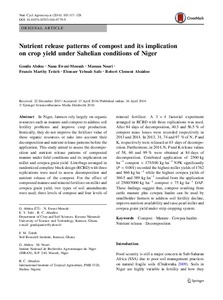| dc.contributor.author | Abdou, G. |
| dc.contributor.author | Ewusi-Mensah, N. |
| dc.contributor.author | Nouri, M. |
| dc.contributor.author | Tetteh, F.M. |
| dc.contributor.author | Safo, E.Y. |
| dc.contributor.author | Abaidoo, R.C. |
| dc.date.accessioned | 2019-12-04T11:04:30Z |
| dc.date.available | 2019-12-04T11:04:30Z |
| dc.date.issued | 2016-06 |
| dc.identifier.citation | Abdou, G., Ewusi-Mensah, N., Nouri, M., Tetteh, F.M., Safo, E.Y. & Abaidoo, R.C. (2016). Nutrient release patterns of compost and its implication on crop yield under Sahelian conditions of Niger. Nutrient Cycling in Agroecosystems, 105(2), 117-128. |
| dc.identifier.issn | 1385-1314 |
| dc.identifier.uri | https://hdl.handle.net/20.500.12478/1444 |
| dc.description | Published online: 16 April 2016 |
| dc.description.abstract | In Niger, farmers rely largely on organic resources such as manure and compost to address soil fertility problems and improve crop production. Ironically, they do not improve the fertilizer value of these organic resources or take into account their decomposition and nutrient release patterns before the application. This study aimed to assess the decomposition and nutrient release patterns of composted manure under field conditions and its implication on millet and cowpea grain yield. Litterbags arranged in randomized complete block design (RCBD) with three replications were used to assess decomposition and nutrient release of the compost. For the effect of composted manure and mineral fertilizer on millet and cowpea grain yield, two types of soil amendments were used; three levels of compost and four levels of mineral fertilizer. A 3 × 4 factorial experiment arranged in RCBD with three replications was used. After 84 days of decomposition, 40.3 and 56.5 % of compost mass losses were recorded respectively in 2013 and 2014. In 2013, 31, 74 and 97 % of N, P and K, respectively were released at 63 days of decomposition. Furthermore, in 2014, N, P and K release values of 58, 60 and 99 % were obtained at 84 days of decomposition. Combined application of 2500 kg ha−1 compost + 175/100 kg ha−1 NPK significantly (P < 0.001) recorded the highest millet yields of 1762 and 866 kg ha−1 while the highest cowpea yields of 360.5 and 389 kg ha−1 resulted from the application of 2500/5000 kg ha−1 compost + 75 kg ha−1 DAP. These findings suggest that, compost resulting from cattle manure plus cowpea haulm can be used by smallholder farmers to address soil fertility decline, improve nutrient availability and raise pearl millet and cowpea grain yield under strip cropping system. |
| dc.description.sponsorship | Alliance for a Green Revolution in Africa |
| dc.format.extent | 117-128 |
| dc.language.iso | en |
| dc.subject | Compost |
| dc.subject | Manure |
| dc.subject | Cowpeas |
| dc.subject | Decomposition |
| dc.subject | Food Security |
| dc.subject | Nutrient Release |
| dc.subject | Crop Yield |
| dc.subject | Millet |
| dc.subject | Cowpeas |
| dc.title | Nutrient release patterns of compost and its implication on crop yield under Sahelian conditions of Niger |
| dc.type | Journal Article |
| dc.description.version | Peer Review |
| cg.contributor.crp | Integrated Systems for the Humid Tropics |
| cg.contributor.affiliation | Kwame Nkrumah University of Science and Technology |
| cg.contributor.affiliation | Council for Scientific and Industrial Research, Ghana |
| cg.contributor.affiliation | Institut National de Recherche Agronomique du Niger |
| cg.contributor.affiliation | International Institute of Tropical Agriculture |
| cg.coverage.region | Africa |
| cg.coverage.region | West Africa |
| cg.coverage.country | Niger |
| cg.isijournal | ISI Journal |
| cg.authorship.types | CGIAR and developing country institute |
| cg.iitasubject | Food Security |
| cg.journal | Nutrient Cycling in Agroecosystems |
| cg.howpublished | Formally Published |
| cg.accessibilitystatus | Limited Access |
| local.dspaceid | 80036 |
| cg.targetaudience | Scientists |
| cg.identifier.doi | https://dx.doi.org/10.1007/s10705-016-9779-9 |

